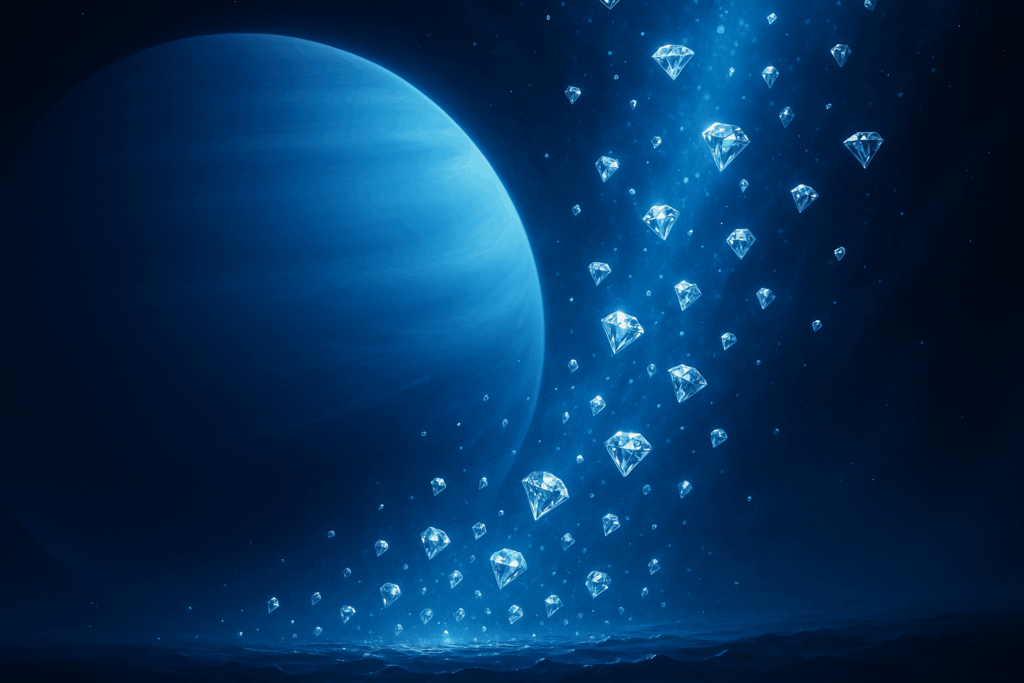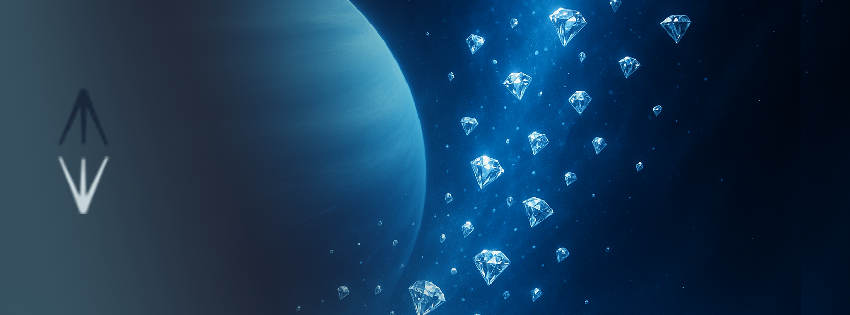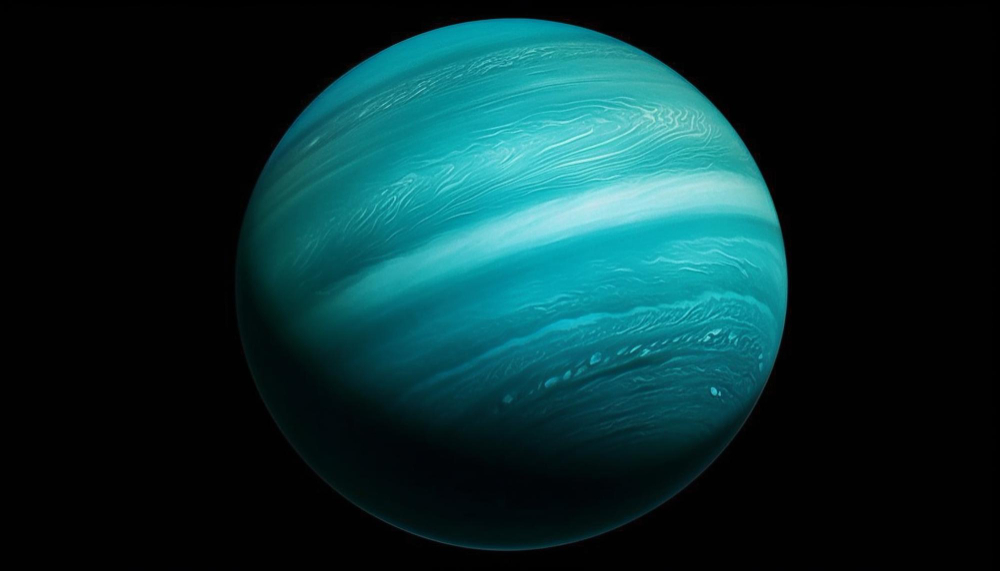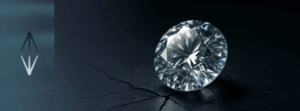The Extraterrestrial Origin of the Atoms in Your Jewelry
Introduction: When Luxury Falls from the Sky
Neptune—and likely Uranus—hide a phenomenon as hypnotic as it is extreme: diamond rain in their depths. There, the mixture of helium, hydrogen, and methane is compressed to gigantic pressures and intense temperatures until the carbon reorganizes into diamond crystals that “hail” toward the planet’s interior. This finding, supported by recent laboratory experiments, not only rewrites what we know about the ice giants but also connects the sparkle of your jewelry to a story that begins among stars, molecular clouds, and blue worlds billions of kilometers away.
1) How Does “Diamond Rain” Form?
Under pressures of tens of gigapascals (millions of times atmospheric pressure) and temperatures of thousands of degrees, methane molecules (CH₄) break apart; the carbon separates and crystallizes into diamond. The micro-gems become denser than their surroundings and slowly fall toward deeper layers, releasing heat in the process.
Recent Key Finding (2024): ultra-fast compression experiments suggest that crystallization could begin at lower pressures and temperatures than previously thought, meaning the “rain” would start in shallower layers than initially estimated. This would help explain the internal dynamics and the unusual magnetic fields of these planets.

2) Guide Table: Approximate Conditions for Diamond “Rain”
Guideline values to communicate orders of magnitude; they vary depending on the model and experiment.
| Parameter | Uranus / Neptune (internal layers) | What it means for the diamond |
|---|---|---|
| Pressure | 10–100 GPa | Necessary to break CH₄ and compact C |
| Temperature | ~2,000–6,000 K | Favors the reorganization of carbon |
| Local Composition | H, He, CH₄ | Methane is the “raw material” |
| Relative Density of Diamond | Higher than the environment | It sinks like heavy hail |
| Estimated Starting Depth | Hundreds to thousands of km | Possible start more superficial after new experiments |
| Global Effect | Release of internal heat | May influence convection and magnetism |
3) From Neptune’s Sky to the Core: The Diamond’s Inner Journey
Once formed, the diamond particles precipitate toward the core like a slow, perpetual snowfall. As they sink, they release energy (latent and frictional heat) that could power deep currents and alter the planet’s magnetic structure. Although no camera will ever “see” this rain, high-pressure physics and indirect signals make it increasingly plausible.
4) The Stellar Origin of Your Jewelry
The story becomes intimate when you look at your ring: the carbon atoms that compose it were born in stars. In red giants and supernovas, the triple-alpha process fuses helium into carbon. After the explosion, that material travels through the galaxy, mixes into a molecular cloud, and, millions of years later, forms the Solar System. Part of that carbon crystallized under the Earth’s crust in extraordinary conditions, giving rise to the diamonds we wear today.
“The nitrogen in our DNA, the calcium in our bones, and the carbon in our diamonds were forged in stars that died eons ago.” — Carl Sagan
5) Narrative Table: From the Cosmos to the Display Case
| Stage of Carbon’s Journey | What happens? | Result |
|---|---|---|
| Stellar forge | Fusion in red giants and supernovas | Birth of carbon |
| Interstellar dust | Carbon travels in grains and nano-diamonds | Seeding the protosolar cloud |
| Birth of the Solar System | Planets and oceans of C-rich compounds form | Earth with abundant carbon |
| Earth’s depths | High pressure and temperature under the lithosphere | Natural diamonds |
| Human hands | Extraction, cutting, and setting | Jewelry that tells a cosmic story |
6) Myths and Realities (Quick)
-
Myth: “If it’s a diamond, it comes from erupting volcanoes.”
Reality: Most natural diamonds form at great depths and reach the surface via ancient kimberlites, not common lava. -
Myth: “Space diamonds are the same as jewelry diamonds.”
Reality: Meteorites are rich in nanodiamonds and peculiar forms like lonsdaleite; many are not cuttable gems. -
Myth: “Diamond rain has been proven with images.”
Reality: It’s indirect: supported by models and high-pressure/temperature experiments, with no direct in-situ observation yet.
7) Quick Questions to Satisfy Your Curiosity (Table)
| Question | Brief Answer |
|---|---|
| Can it rain diamonds on other planets? | Yes: Uranus is the main candidate; minor scenarios have been proposed for Saturn. |
| Will we be able to “see” that rain? | Not directly for now; probes could detect indirect signatures. |
| Are there space diamonds on Earth? | Yes, nanodiamonds in meteorites and rare carbonados. |
| Do my jewels contain atoms from Neptune? | Not those specific crystals, but perhaps carbon atoms forged in the same interstellar cloud that formed us. |
8) Conclusion
Each diamond holds two extraordinary journeys: one current, in the deep skies of Neptune, where a snowfall of gems may be falling; and another ancestral, in stellar furnaces that created the carbon in your jewelry. The next time your diamond catches the light, remember: its sparkle summarizes billions of years and billions of kilometers.
Credits and Recommended Readings (No Links)
American Scientist · SLAC National Accelerator Laboratory · Carnegie Science · Phys.org · Natural History Museum · Live Science · SpaceDaily





